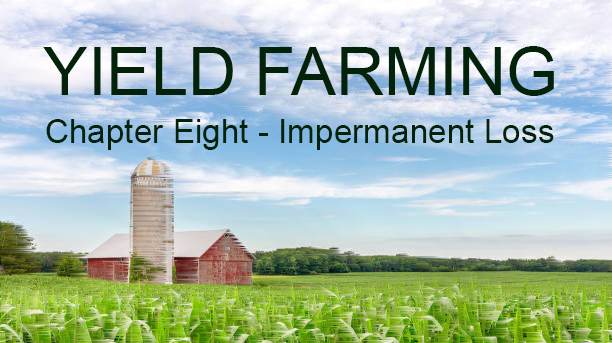Yield Farming Chapter Eight - Impermanent Loss

This is Chapter Eight, focused on Impermanent Loss, in a series of articles that will be released about yield farming. The purpose of this series is to introduce the concept of yield farming to those who are unfamiliar with it, then move into various yield farming strategies and finally step-by-step walkthrough of the process. I hope you enjoy the series and any feedback you have would be greatly appreciated.
Chapter Eight - Impermanent Loss
Impermanent (adjective) not permanent
Loss (noun) the fact or process of losing something or someone
Impermanent loss (IL) is a scary sounding phrase that keeps many from exploring yield farming, specifically providing liquidity. But what is it and is it really that bad?
What is Impermanent Loss?
Impermanent loss can occur when you provide liquidity to a liquidity pool by combining two coins or tokens into one liquidity pool (LP) token. These tokens must, in most cases, remain in a 50/50 split in terms of value so when the price of one of the assets changes in comparison to the other after the point in which you created them the underlying coins must adjust to retain the 50/50 value split. The larger the price changes, regardless of the price change going up or down, the larger the impermanent loss.
The loss is calculated against what you would have in terms of total value if you just continued to hold the two coins at the time of deposit instead of combining the two into a LP.
When is Impermanent Loss incurred?
While the value of the LP tokens you hold change all the time as the value of each of the two coins change, no realized impermanent loss occurs until the moment you sell your LP tokens or split them back apart. This is similar to holding any individual cryptocurrency in the fact that the price and value of your coins changes all the time but you do not "lock in" a profit or loss until the point you sell. If you are following a HODL strategy, the short-term price movements of a coin shouldn't matter that much.
In many cases, impermanent loss is offset by the rewards one receives while holding their LP tokens.
Impermanent Loss example
Many people like to create LP tokens which include one stable coin. For example, let's say you want to yield farm using a LP token that combines Ethereum (ETH) valued at $2,000 at the time of deposit and Tether (USDT) valued at $1.00 and remains at that value throughout. You decide to invest $2,000 of which half will go ETH (.5 ETH for $1,000) and 1000 USDC.
If ETH increases 25% to $2,500 at the point in which you sell the total value if you simply held both tokens would be $2,250 as you would gain $500 on the ETH gain.
Because the ETH/USDC LP token must remain at a 50/50 split in terms of value, you new amount of ETH coins would decrease to 0.44721 while your USDT coins would increase to 1,118.0 resulting in a total value of $2,236.07 or a total loss of $13.93. The greater the price movement, the greater the loss of what you would have had if you simply just held the coins.
Once again, these losses can be offset by the rewards earned by holding the LP tokens. There are a number of IL calculators that can be used including a simple one on Upoint.
Strategies to limit Impermanent Loss
There are a number of strategies that can be employed to limit the potential impermanent loss. The above strategy isn't necessarily a strong one since you can almost be sure that the non-stablecoin portion of the LP token will certainly change while the stablecoin remains constant virtually guaranteeing impermanent loss.
Two Stablecoins - theoretically stablecoins should maintain their price over the long-term so by entering a liquidity pool with two stablecoins, such as USDT and BUSD, should incur no impermanent loss over time.
Coins that move together - many cryptocurrencies tend to move in conjunction with one another. Generally, Ethereum will follow the price of Bitcoin. There will of course be some variation, however, impermanent loss should be minimized when pairing coins or tokens that have similar price movement.
Using a pegged coin - there are a growing number of liquidity pools that use LP tokens that are a combination of a coin and a token pegged to the price of that token. While pegged tokens can move "off peg" they generally stay pretty close and therefore the two coins have price movements that mirror each other.
New coins or tokens are often paired with some of the top coins to provide liquidity within their ecosystem and offer very high rewards. Newer coins, however, often have a lot of price volatility and the attractive rewards are unlikely to offset the impermanent loss and should be avoided, especially for those new to yield farming.
Whiteboard Crypto YouTube Video - What is Impermanent Loss in Crypto?
Previous Chapters
Yield Farming Chapter One - What is Yield Farming?
Yield Farming Chapter Two - Decentralized Finance
Yield Farming Chapter Three - Automated Market Maker
Yield Farming Chapter Four - Liquidity Pools
Yield Farming Chapter Five - Smart Contracts
Yield Farming Chapter Six - APR vs APY
Yield Farming Chapter Seven - Gas Fees, Slippage and Other Fees